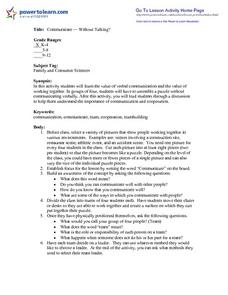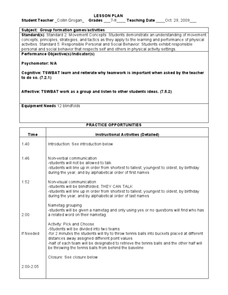King Country
Lesson 9: Communication - Day 2: Assertiveness
Appropriate assertive and non-verbal assertive communication is the focus of this lesson designed for the special education classroom. Using mirrors, class members practice assertive responses to a variety of situations.
Curated OER
Zapped! (Non-Verbal Communication)
Young scholars communicate non-verbally while playing a game. They get other students in the room to sign a form, without speaking. They continue to collect signatures, until one of them who has been chosen to control the game winks at...
Odyssey of the Mind
Odyssey of the Mind Curriculum Activity: GREAT TO COMMUNICATE
Humans love to communicate and they do it in so many different ways. The class investigates how people have used new inventions and technological innovations to communicate. They are divided into groups of three or four and given...
Texas Education Agency (TEA)
Managerial Communications
Communication is key. Pupils receive direct instruction about managerial communications and then independently research communications careers. Scholars then complete exit tickets, answering questions about what they learned.
profitt.gatech.edu
Effective Communication: Listening, Speaking, Writing, Interpreting
Help young learners become active listeners and strong public speakers with a set of activities that range from paraphrasing, to discussions, and self-reflection. Additionally, the lessons address social media skills and non-verbal...
Curated OER
The Artist As Entrepreneur: You Say Tomato, I See Tomato
High schoolers compare phone negotiations with in person negotiations to identify the non-verbal communication that is produced in face-to-face meetings. They practice forms of non-verbal communication by reciting the alphabet and...
Curated OER
Communication, Day 2: Assertiveness
Having social skills and being able to assert yourself in a positive way is so important. Students with mild to moderate disabilities engage in a series of activities to practice assertive communication and social skills. Perfect for a...
Curated OER
Fabulous Felines
Young scholars learn how cats communicate with humans. In this non verbal communication lesson, students learn how cats communicate with humans. Young scholars discuss how they communicate their thoughts and feelings and the differences...
Curated OER
The Human Animal
Middle schoolers explore non-verbal communication. In this animal communication lesson, students study body language and other forms of non-verbal communication. Middle schoolers write a summary of their findings to discuss with the...
Do2Learn
"I Have a Question..." Communication Board
Support nonverbal communication with a communications boards that features 20 pictures that answer questions such as How are you?, Why?, Who are you?, and more.
Curated OER
Treasure Hunters
High schoolers design an on campus treasure hunt to find various architectural vocabulary words which they then create definitions for on the blog page on the Environmental Design website.
Curated OER
What Did You Say?
Second graders role-play various situations in which they use verbal and non-verbal communication.
Curated OER
Challenge to Communicate
Learners use Lewis and Clark's journals to identify the forms of non-verbal communication they used. They discover the problems they faced on their journey and how they overcame them. They practice using the non-verbal language of the...
Curated OER
Communicate - Without Talking?
Young scholars discuss and define communication and identify different ways of communicating with people. Students then practice team building and non-verbal communication skills as they work silently in small teams to put puzzles together.
Do2Learn
Activities: Everyday
Give learners the tools to communicate through physical actions and hand gestures, as well as verbally, by using this comprehensive set of picture cards that describe everyday activities. Some of these activities include...
Do2Learn
Communication Board
Help nonverbal individuals navigate a very verbal world with a helpful communication board. After they fill in their name to introduce themselves to others, learners can point to written responses to yes or no questions, as well as...
Do2Learn
"I Need Help" Communication Board
Help scholars communicate their needs with a communications board equipped with 20 pictures including the needs of clothes, school supplies, and more!
Do2Learn
Social: Emotions, Health, and People
Picture cards can be a fantastic tool that learners can utilize to communicate their emotions and needs. This set of cards illustrates not only basic emotions, such as happiness, fear, or anger, but also certain illnesses a...
University of Oklahoma
Improving My Communication Skills
The two lessons in the fifth unit in this series are designed to help students with disabilities improve their communication skills. The first lesson has class members practice strategies and skills for appropriate communication. They...
Curated OER
Non-verbal Cues
Young scholars distinguish between verbal and nonverbal communication. In this communication series lesson, students identify the emotions portrayed by photos shown. They role play examples of good and bad listening skills.
Curated OER
Leadership: Communicating With Your Peers
Students explore communication by using non-verbal cues. In this body language lesson, students utilize blindfolds to communicate with classmates through words only, then use only physical actions to communicate and compare the two....
Curated OER
Challenge to Communicate
Learners examine the journals from Lewis and Clark and identify how they spoke without using words. They participate in a game in which they use non-verbal communication with each other. They write their own journal entries to complete...
Curated OER
ASL: Lesson 5
Sign language is an effective way to communicate with those special needs, hearing, impaired, and non-verbal pupils. This lesson provides a highly structured way to learn or teach ASL. Included are multiple links to images, descriptions,...
Do2Learn
Self Help: Body Parts
Head and shoulders, knees and...ears? Eyes? Hands? Help learners get the parts of the body straight with this set of 12 picture cards!

























